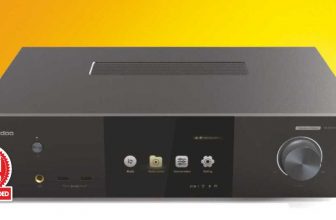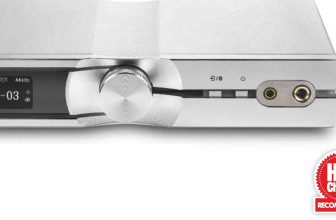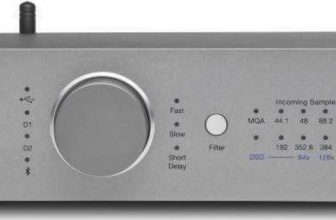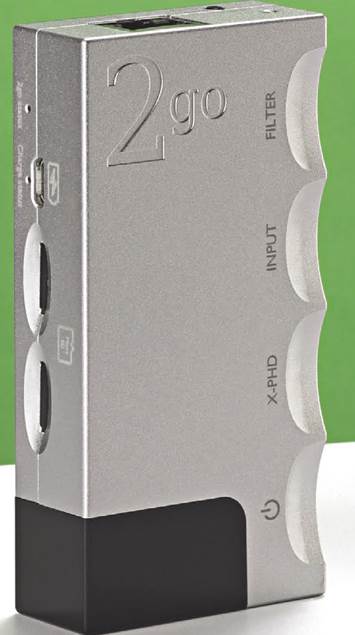Auralic Altair G2.1 Review
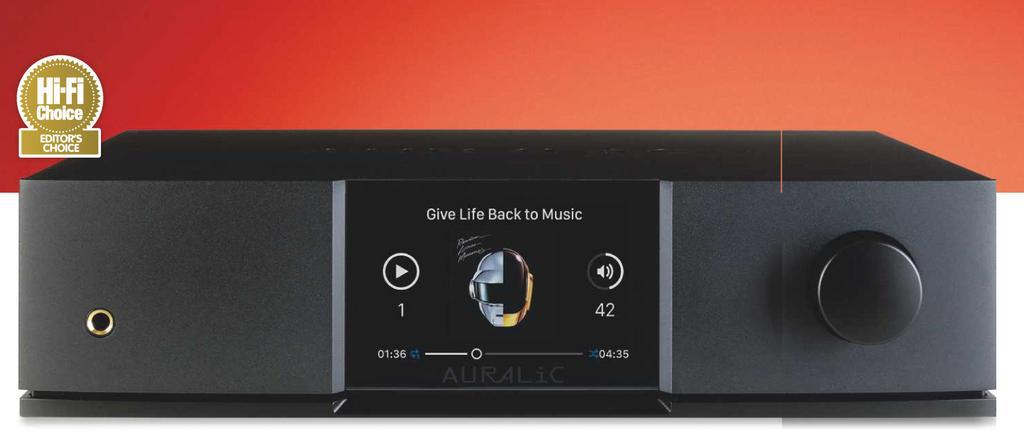
Altair’s G2.1 costs a wee bit more than its Aries G2.1 (HFC 469) ‘Wireless Streaming Transporter’ – and yet this model, designated a ‘Digital Audio Streamer’, is a far more comprehensive product. It comes complete with onboard DAC, a preamp that allows it to drive a power amplifier or a pair of active speakers directly, and there are even analogue inputs – a line-level and moving-magnet phono – to further reinforce that role as a complete system hub.
If you choose to do so, you can go even further with the option of an internal hard drive to allow the Altair G2.1 to function as a network music store as well as accessing external storage. Specifying it with a 2TB SSD installed adds £ to the price, while looking around Auralic’s retailers finds it with a 1TB SSD fitted for £ or a 4TB drive for £. All these are reasonable add-on costs considering the premium that’s usually charged by some computing brands for such storage upgrades.
Take it as it comes
Purchased ‘as it comes’, without the internal storage options, this is still an extremely flexible device. Leave aside the analogue capability for a moment, and you can play music into it via optical, coaxial and AES/EBU inputs; connect up a computer via its asynchronous USB-B port or an external USB storage device using the USB-A; or stream to it over a home network using either wi-fi (for which twin antennae are provided) or Ethernet. It additionally has both Bluetooth and AirPlay connectivity and is also Roon-ready, allowing it to be used as an endpoint with a system built around a Roon Core.
If you don’t go down the Roon route, the Altair G2.1 itself supports a range of online streaming services, as well as being able to play music from the user’s own network library. Qobuz and Tidal are built-in, as is Internet radio, and it can also work with Songcast and Spotify Connect.
Making sense of all this is Auralic’s famed Lightning DS operating system, which works in conjunction with the well-sorted app of the same name, and is available for Apple iOS devices. There’s also the option of controlling the unit using the Lightning Web Control Interface: it’s just a matter of reading the Altair G2.1’s IP address from its settings menu, typing that into a web browser and you’re in business and ready to roll.
The app and the web version cover basic operation and more detailed settings. You can, for example, enable the internal resampling system, upsampling or downsampling across a 44.1kHz to 384kHz range – all this running under the control of Auralic’s custom ‘Dual Femto’ master clocks. There’s also a built-in – and very flexible – parametric equaliser, and you can even tailor the sound to suit your loudspeaker positions, with adjustable gain and distance parameters. It’s no substitute for getting your speakers placed correctly, of course, but in the real world it could prove very handy indeed.
Dig even deeper and there’s a huge raft of adjustment available here, including setting a fixed output should you want to use the Altair G2.1 into a conventional amp or preamp. You can also set the brightness and format of the display, the automatic power-on parameters and even select from a range of different digital filter options.
The Altair delivers great levels of musical detail over a wide range of genres
Having spent some serious time experimenting with said filters, we would suggest the one you choose will be down to a matter of personal preference. Find the one you like – we end up with ‘Smooth’, but you may disagree – and then forget about it.
Depending on the input you choose, the Altair G2.1 can handle digital datastreams at up to 32-bit/384kHz and DSD512, the higher limits achievable via both network and USB connection from a computer (for which Windows users will, of course, need to download a driver) or USB storage – whether from a connected drive or optional internal storage. The legacy digital inputs – optical, coaxial and AES/EBU – top out at 24-bit/192kHz, but can accept DSD64 via DoP if required.
The analogue line and MM phono inputs bypass the digital wizardry of Auralic’s ‘Tesla’ platform and can be configured to fixed level in a ‘home theatre bypass’ mode. These inputs also go straight to Auralic’s ‘resistor-ladder’ volume control and to its proprietary ‘Orfeo’ Class A output stages to either unbalanced RCAs or balanced XLRs. There’s also a 6.35mm headphone output on the front panel, along with a large, sharp and informative display and a single control covering volume and ‘push and twist’ menu access.
As is the case with all the company’s G2.1-series products, the latest Altair features Auralic’s interference-busting ‘Unity Chassis’ design, its copper inner case supported within a substantial aluminium chassis mounted on sprung feet for mechanical isolation. That’s the inside story: the outer impression is of a product hiding its complexity behind a simple and elegant exterior, and with a noticeable sense of solidity when you remove it from the packaging – it may only be 34cm wide, but it weighs in at a more than respectable 9.5kg.
Sound quality
We decide to stick with the ‘Smooth’ digital filter for the majority of our listening, and use the Altair G2.1 straight into a Naim NAP 250 power amp, as well as connecting it as a line source into the Supernait 3 (HFC 456) in our ‘other’ system, in both cases using our tried-and-tested Neat Acoustics and PMC loudspeakers for auditioning. Regardless of which setup is employed, the Altair G2.1 proves to be a neutral and extremely clean source, presenting high levels of detail while never sounding mechanical or artificial in any way. Indeed, it delivers excellent levels of musical involvement across a wide range of different musical genres, again, regardless of the input used.
Whether with streams from online services, low-res internet radio or hi-res music served up from the NAS, the experience of using the Altair G2.1 is generally a case of ‘move along, nothing to see here’: the components into which you play it are going to have much more of an effect on the sound than this unit. True, the performance is very slightly drier compared with our reference Naim ND 555, which delivers more body and a greater sense of presence and performers being placed before the listener, but that’s hardly a criticism given the price difference.
Above all, the Auralic ‘communicates’. Play a demanding recording such as the recent Trondheim Symphony Orchestra set of Kleiberg Concertos, and the sheer focus of the sound and the natural balance of the solo instrument against the rich weight of the orchestra is breathtaking. As, we should add, is the sense of presence and space in the soundstage, and the speed and rhythmic drive on offer.
The same goes for Charlie Haden, Jan Garbarek and Egberto Gismonti’s 1980 Magico album. Here the Altair G2.1 really gets its teeth into the gorgeous production, allowing the sax to soar above the deep, superbly resolved bass, while the guitar and piano are also given full licence to be heard to thrilling effect. It’s all so effortless, as well as being a richly rewarding listen, and the recordings don’t have to be state of the art for this player to work its magic.
The G2.1 proves an extremely clean source, presenting high levels of detail
Even with the Bill Evans take on Alfie from his Another Time – The Hilversum Concert album, recorded (admittedly magnificently) back in 1968 and revived to DSD by the 2xHD label, the sound brims with the easy going interplay between Evans, Eddie Gomez and Jack DeJohnette in front of a small audience. It’s a joyous experience via the Altair G2.1.
The timbres of real voices and instruments are a major strength here too, for while mainstream pop is revealed in all its autotuned awfulness, give it something like Little Black Dress from The Blessed Unrest, the 2013 Sara Bareilles album, and it punches out not only every line of the vocal, but also the gutsy accompaniment, with real definition and impact. It’s a sound that leaves you wanting to explore more of the singer’s catalogue, and you can’t ask much more than that!
It’s also as adept when growling out some hard driving rock as it is when playing more refined, hi-fi-show-friendly music. This review period coincides with the sad demise of ZZ Top bassist Dusty Hill, which inevitably leads to a couple of evenings immersed deep in the beardy band’s trademark Texas boogie. We can truly attest that, from the slow-burn blues of Just Got Back From Baby’s all the way through to Billy Gibbons’ charging guitar solo that drives the epic chart hit Cheap Sunglasses, this new Altair does the exhaustive Goin’ 50 Best Of… compilation – that we choose as the accompaniment to toasting (several times) the lamented Dusty – proud.
Conclusion
The Altair G2.1’s analogue output happily drives the amplification, and thus the speakers, to suitably raucous effect while still keeping those good-time rhythms rolling as the trio powers on. We even play the odd track – well all right then, quite a lot of them – several times, just to immerse ourselves in the majestic thunder and gutbucket snarl. And it proves deeply impressive every time
ORIGIN China
TYPE Network-attached streamer/DAC
WEIGHT 9.5kg
DIMENSIONS (WxHxD) 340 x 80 x 320mm
FEATURES
• Supports sample rates up to 32-bit/384kHz and DSD512
• Wired and wireless networking
• Inputs: line-level RCA; MM phono stage; optical; coaxial; AES/EBU; asynchronous USB-B; USB-A; Ethernet
• Bluetooth; AirPlay; Roon Ready
DISTRIBUTOR Auralic Europe
WEBSITE auralic.com
HOW IT COMPARES
The Altair G2.1 is not just a network-attached DAC/preamp but, with the addition of onboard storage, morphs into a self-contained music library/digital hub that’ll service the most progressive of hi-fi systems. Digital output-only music libraries including those from Melco, the Roon Nucleus + ( HFC 439) and very high-end Grimm Audio MU1 are certainly worth checking out if you are already wedded to your own choice of USB/AES DAC.
However, for ‘complete’ solutions that vie directly with the Altair G2.1 you should seek out the RS150B from newcomer HiFi Rose ( HFC 477). This fine-sounding and very versatile solution comes with its own super-flexible (and very stable) control app. By way of a leftfield option, and if you are flush with budget, Aurender’s A30 will appeal to audiophile high-enders – a snip at £!
CONNECTIONS

- Ethernet port
- USB-B/A ports
- Optical input
- Coaxial input
- RCA output
- Balanced XLR output (right channel)
- AES/EBU input
- RCA line-level inputs
9. Moving-magnet phono stage input
IN SIGHT
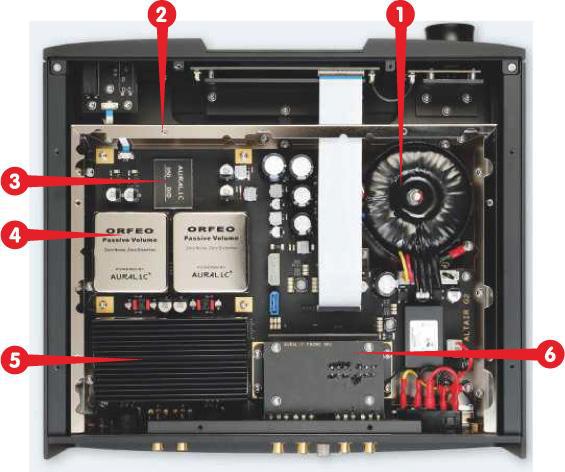
1 Substantial linear power supply
2 All electronics are screened within a secondary case
3 DSD/DXD- compatible DAC, with local clock, is screened under a can
4 Ladder-style stepwise volume control(s) for left and right channels
5 Class A Orfeo Output modules (under heatsink) feed line and headphone outputs
6 MM phono stage bypasses Auralic’s digital ‘Tesla’ platform
SOUNDING GOOD, LOOKING GOOD
Founded back in 2009, US streaming specialist Auralic has established a much-deserved reputation around the world for creating innovative digital audio components of the highest quality.
Auralic says it designs its products to combine classic analogue features with cutting-edge digital technologies, the goal being: “to forge new pathways into the future of high-performance audio”.
The company claims its integrated hardware and control software have been fashioned with a view to providing effortless command of high-resolution music playback throughout the home. Whether streaming from internet services or personal music collections, Auralic says its philosophy is to combine components which: “let you discover, share and connect like never before, expanding the horizons of your audio system with new levels of functionality and performance”.
The company’s products have a reputation for looking good as well and, just like the much-lauded earlier Altair G1 (HFC 455), the brand new G2.1 variant reviewed here has been designed to please the eye.
The streamer’s physical construction includes Unity Chassis II, which the company describes as: “a stealth-silent aluminium enclosure encapsulating a highly effective copper sub-enclosure that protects the advanced internal electronics from outside interference”. It also sports a massive aluminium base and a six-spring suspension footer system, which Auralic claims all adds up to a: “quiet, sublime, musical performance”.


